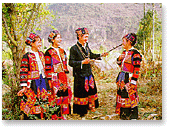Home » Lo Lo
The “Lo Lo” People

According to the survey data officially announced in 1989 by the State, the Lo Lo ethnic group’s population stood at around 3,200, residing in Cao Bang, Ha Giang and Lao Cai provinces, largely in the districts of Bao Lac (Cao Bang), Dong Van and Meo Vac (Ha Giang), and Muong Khuong (Lao Cai). Like some other ethnicities in northern Vietnam, the Lo Lo have had their origin in southern China regions such as Sichuan and Yunnan provinces, who, according to historians and ethnologists, had established the Nam Chien state by the end of the first millennium.
The people of this ethnic minority group living in southern China have been named “Di”, while those residing in Viet Nam have called themselves Man Di, Man Chi or Mun Di (with Man meaning “people”). According to their particular costumes and culture, the Lo Lo can be divided into two sub-groups: The “Lo Lo Den” residing in the districts of Lung Cu and Dong Van of Ha Giang and Bao Lac of Cao Bang province, and the “Lo Lo Hoa” living in Meo Vac and Dong Van districts of Ha Giang province.
The Lo Lo migrated to Viet Nam right by the end of the first millennium, but largely in the 15th and 17th centuries. They have lived mainly on farming and husbandry. From their early days, the Lo Lo have known how to practice intensive rice farming on their fields and milpas.
Though staying mixedly with people of other groups such as Mong, Tay, the Lo Lo have established their own small hamlets where their residential houses have been built leaning against the mountain slopes with doors turning to valleys. They have a high sense of protecting forests and the greenery around their hamlets in order to ensure sources of daily-life water. The Lo Lo have held that forests and gardens around their residence are places where deities reside; hence, they must be protected.
There are three types of houses built by the Lo Lo: the houses on stilts, the earthen houses and stilt-cum-earth houses. A stilt-cum-earth house is built with two parts: the stilted part is in the front and the earthen part is behind. The familiar architectural style seen among the Lo Lo community is the one-compartment and two lean-to house. In a house, the “house ghost” altar is erected close to the middle compartment wattle. To the right of the altar is the sleeping place being kept warm with the kitchen fire. To the left of the altar is the cooking range and storeroom where household utensils and working tools are kept. For big families, this place is also used as a sleeping place. Worthy of note is that also erected in a Lo Lo house is another altar, which is called “khoan ly” by people of this ethnos, for family members who die of accidents or die in their shoes. To the Lo Lo, this is the most sacred place of a family where only the family master is allowed to come and do the cleaning.
The Lo Lo costumes (especially the women’s) are very particular and elaborately tailored. The difference between those worn by the women of the two Lo Lo subgroups – Lo Lo Den and Lo Lo Hoa – is so distinct, from the decorative patterns on fabrics to the ways of tailoring, that one can easily tell women of one subgroup from those of the other. Yet, that is not the case for men’s costumes which have been designed and made under the strong influence of the Tay and Mong minorities in the region.
Formerly, the Lo Lo society was characterized by strong class disintegration. Each hamlet accommodates many descents and each descent comprised only a few households or even only one. And each descent has several branches from three to five generations apart. Such branches often live in the same hamlet, worship the same ancestors and share a set of bronze drums. Each branch is headed by an aged man called “thau chu” who has the task of taking care of the common affairs of the entire family branch, preserving its own customs and practices, presiding over its own rituals, solving differences and disputes among branch members or between members of his branch and those of other branch(es). Members of family branches have been bound closely together not only by bloodline but also by their mutual care and assistance in their daily life.
The Lo Lo people have advocated the patriarchy though matriarchal traces could be seen here and there, particularly in the role played by the women’s elder brothers in the family. Such men have had full power to ask for the wedding presents when their nieces get married. When a woman dies, her young brother must be let to see her face before the corpse is shrouded.
According to Lo Lo customary laws, when a man dies, his son-in-law shall have to carry one end of the coffin and shall, together with his brothers-in-law, have to throw the first earth balls into the grave of the deceased after the coffin is lowered thereinto. As a must for the Lo Lo funeral, dancing is organized for three to five days to see off the death to see their ancestors. In the funeral procession, the groom must always be in the van carrying on his shoulder a fabric bag containing a wooden skull wrapped in cloths which symbolizes the skull of the deceased.
Monogamy and patrilocality have long been advocated and practiced by the Lo lo. Formerly, according to Lo Lo customs and practices, the marital age used to be 13 – 14. Intra-ethnos marriages were strictly observed while adulteries were brought to trial and severely punished under the customary laws which, however, permitted the marriage between a man and his sister-in-law when his elder brother died. Marriages between daughters of brothers and sons of their sisters were very common. When a man got a newly born daughter, his sister brought a square of fabric as the present to her newly born niece, which was understood as a form of plighting.
The Lo Lo family is typified as the small patriarchal family in which the patriarch (the father or the unmarried eldest brother if the father has died) has the responsibility to take care of the entire family, deciding working plans and expenditures for the whole family and representing his family in its relations with other families. The family patriarch is the only person in the family allowed to worship the “house ghost”. He is also the person who has, together with the family line chief, called “thau chu”, the final say on big and important affairs of the family after consulting with a number of family members.
The Lo Lo people have been accustomed to worshipping their ancestors, including the near ancestors (forefathers of 3 to 5 generations), called “duy khe”, and the distant ancestors (forefathers of 4,5 or more generations), called “po xi”. Each family has its own altar for worshipping “duy khe”. However, the worshipping of “duy khe” is often conducted at the house of “thau chu” (the family branch chief) during the Lunar New Year Festivals and on the mid-seven moon (the dead’s day). Besides, rituals to worship “duy khe” are also held by people when someone in the family gets sick or accident.
Under the Lo Lo customary laws, when the parents in a family die, only sons are entitled to inherit the family property while the girls may enjoy the jewelry of their mother when she passes away or be given a part of the family property as their dowries when getting married.
The private ownership of property by individuals and families has been respected. All acts of infringing upon other people’s property shall be charged with robbery and burglary and severely punished. Perhaps, this may help to explain why such social vices have been hardly seen among the Lo Lo community where the people’s living standards still remain low.
The Lo Lo customs, practices and customary laws bear distinct cultural identities of this ethnic group whose new culture cannot be built without inheriting such cultural traditions, which have been established and passed from generation to generation now.–Viet Nam Law & Legal Forum.

